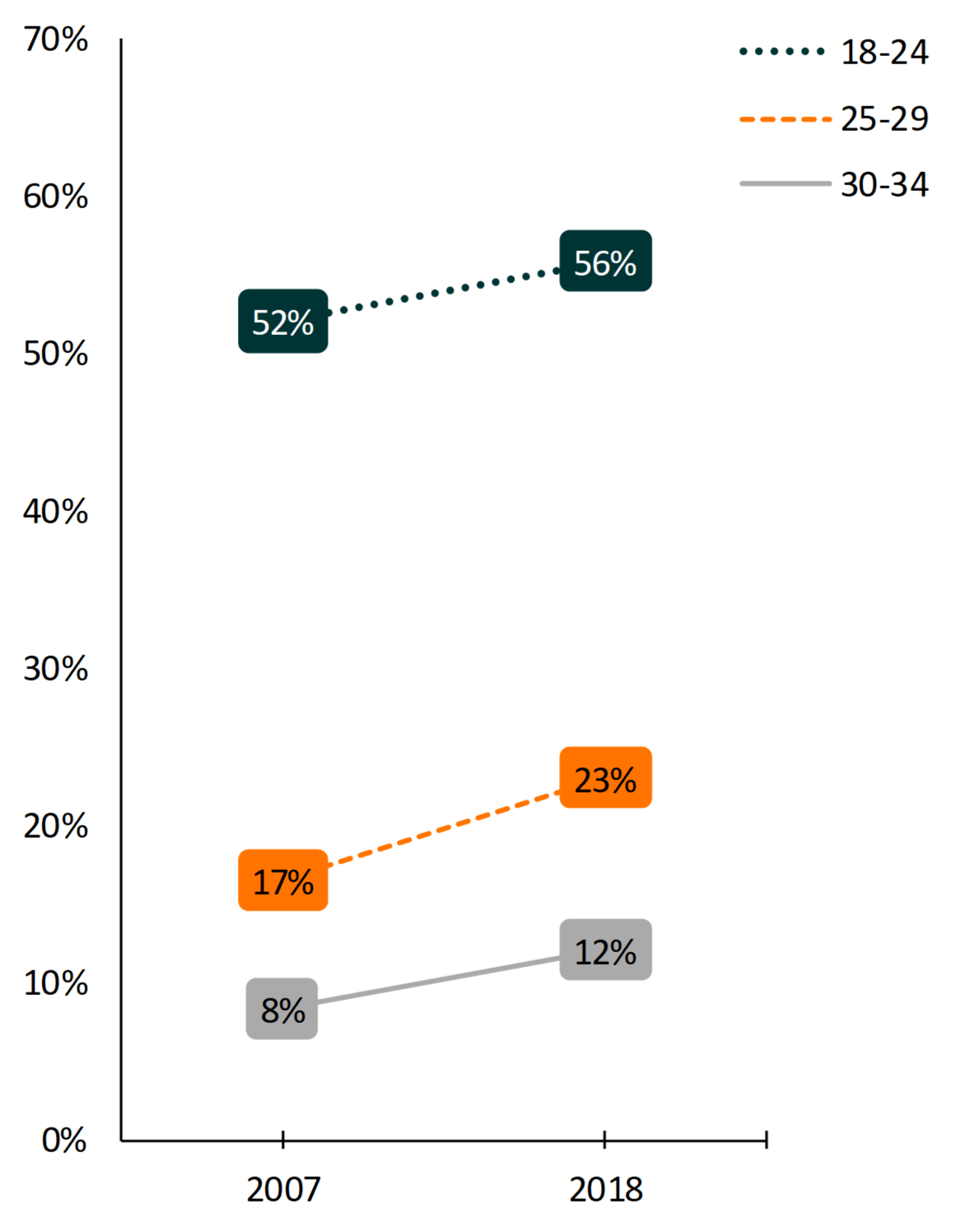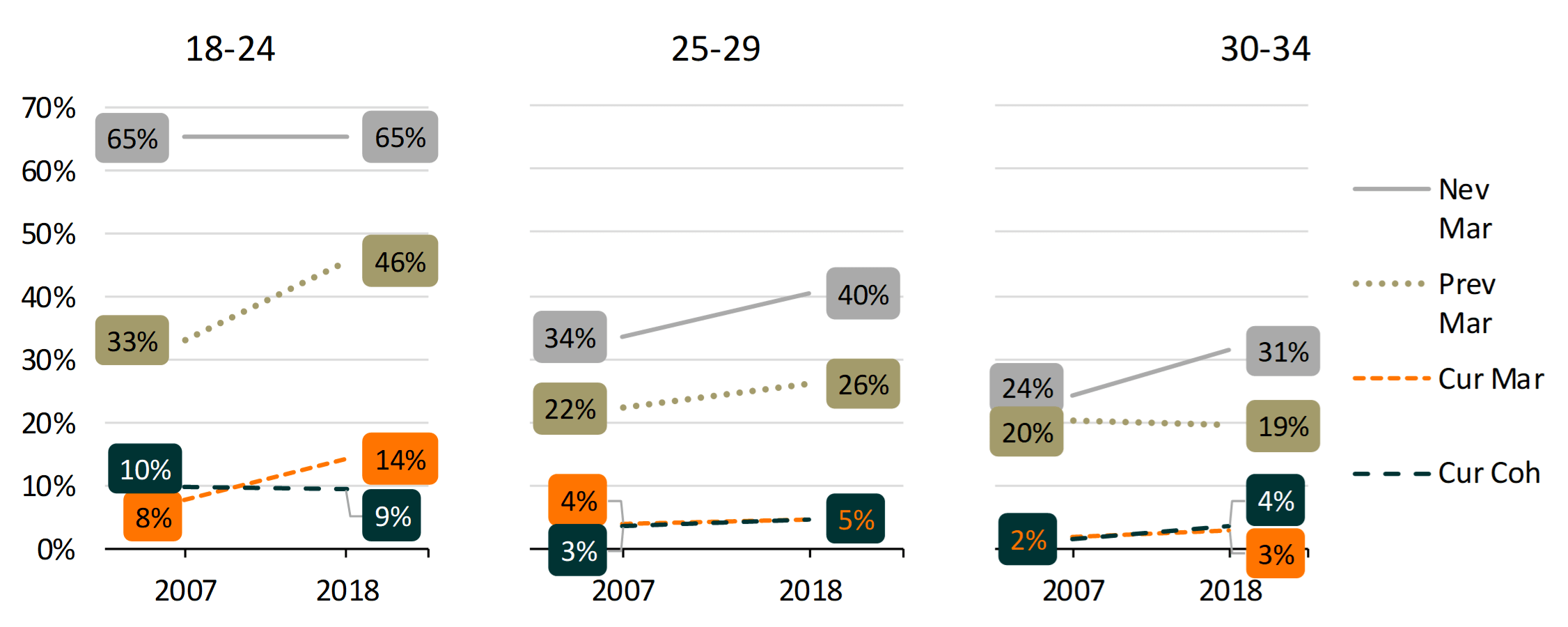Young Adults in the Parental Home, 2007-2018
Family Profile No. 04, 2019
Author: Krista K. Payne
Young adults often co-reside with their parents in response to economic distress (Furstenberg, 2010; Settersten & Ray, 2010), although for some, it is their preferred living arrangement. Not all young adults who co-reside with a parent are single - some are cohabiting or married. By using the Current Population Survey’s (CPS) detailed information on both marital and cohabiting partners (which are not available in either the Decennial Census or the American Community Survey), we produce detailed information on young adult parental co-residence by relationship status from 2007 through 2018. We define parental co-residence as living with one’s own parent(s) or a partners/spouse’s parent(s).
Share of Young Adults Living in the Parental Home by Age Group
- In 2018, 33% of young adults aged 18-34 were living in a parent’s home, up from 29% in 2007 (not shown).
- All young adults, regardless of age group, experienced an increase in co-residence since 2007. However, prevalence and patterns differ by age group.
- The share of young adults aged 18-24 co-residing with a parent has leveled off at 56% over the last six years.
- Coresidence among those aged 25-29 has continued to rise, peaking at nearly one in four (23%) in 2018.
- Among the oldest age group examined, 2018 also represents the highest share co-residing, with 12% of those aged 30-34 living in a parent’s home.
Figure 1. Share of Young Adults Living in Parental Home by Age Group, 2007-2018

Share of Young Adults Living in the Parental Home by Relationship Status and Age Group
- Parental co-residence was highest among young adults at younger ages regardless of relationship status.
- Across all age groups, single young adults (not in a marital or cohabiting union) experienced higher shares co-residing
with a parent than those in a current union.- Overall, never-married young adults most often co-resided with parents. More than three-fifths of those aged 18-24 and nearly one-third of those aged 30-34 never-marrieds lived with their parents.
- Parental co-residence was lowest among the currently married and currently cohabiting, with virtually no differences
between the two union types, except among those in the youngest age group (18-24).- In 2018, a slightly larger share of married 18 to 24-year-olds were living with a parent (14%) compared to cohabiting 18 to 24-year-olds (9%).
- Among married and cohabiting 25 to 29-year-olds, about 5% lived in a parental home versus only 3-4% of cohabiting and married 30 to 34-year-olds.
Figure 2. Share of Young Adults Living in Parental Home by Age Group and Relationship Status, 2007-2018

Source: NCFMR analyses of IPUMS-CPS, 2007-2018, University of Minnesota
Data Source
- Flood, S., King, M., Rodgers, R., Ruggles, S., & Warren, J. R. (2018). Integrated Public Use Microdata Series, Current Population Survey: Version 6.0 [dataset]. Minneapolis, MN: IPUMS. https://doi.org/10.18128/D030.V6.0
References
- Furstenberg, F. F. (2010). On a new schedule: Transitions to adulthood and family change. The Future of Children, 20(1), 67–87. https://dx.doi.org/10.1353/foc.0.0038
- Settersten, R. & Ray, B. E. (2010). Not quite adults. New York: Bantam Books.
Suggested Citation
- Payne, K. K. (2019). Young adults in the parental home, 2007 & 2018. Family Profiles, FP-19-04. Bowling Green, OH: National Center for Family & Marriage Research. https://doi.org/10.25035/ncfmr/fp-19-04.
Updated: 11/12/2025 09:29AM


